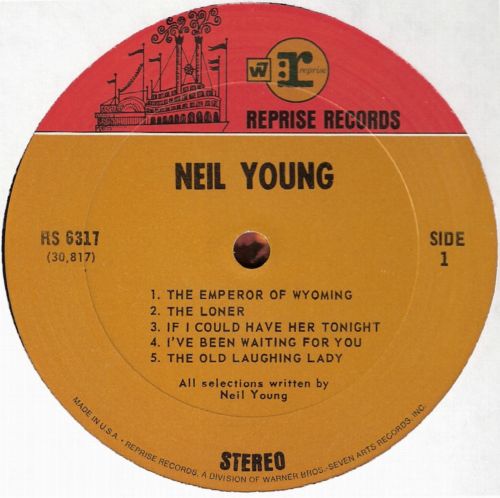

Source: (Side 1: 30 817 RS6317 A -1B / Side 2: 30 818 RS6317 B -1D )
This was transferred from an VG++ graded copy.
Vinyl Transfer & Restoration by Prof. Stoned
-----------------------------------------------------------------------------------------------------------------------------
Prof sez:
I'm proud to present you the rare original version of Neil Young's debut. This version was withdrawn 9 months after its initial release and contains three tracks in a different mix and the whole album in an entirely different mastering. There has been a lot of contradictory information about this subject on the internet, so I'm going to try to set the record straight here.
The album was recorded in the period from mid-August to late October 1968 at the TTG studio in Los Angeles, CA, one of the first studio's to have a 16-track facility at the time. The original US stock version was released on January 22, 1969 and not November (12) 1968 as various sources have claimed. Initial sales of the album were dismal; it's estimated that less than 10,000 Reprise 7-Arts label copies sold in 1969 (including initial sales of the revised version).
When Young and his producer/companion David Briggs delivered the album to Reprise in late '68, they had no idea that their work would fall victim to a new technology that the record company was about to try: the Haeco-CSG "Compatible Mono/Stereo" Process. The idea behind HAECO-CSG was to create stereo records which when played on monaural equipment would "fold-down" properly to mono, Predictably, the process also resulted in lessening of sound quality.
Mr. Young was furious when he learned about this practice and demanded the record to be withdrawn and replaced with a properly mastered version. Considering that his career at this point was not exactly a success story, the record company willingness to do so can be called a small miracle. But it would take no less than nine months before this new version was completed and released, due to other activities (recording a 2nd album, joining CSN and playing live). In the process, Neil also started to have second thoughts about the mixes of "Here We Are In The Years", "What Did You Do To My Life" & "If I Could Have Her Tonight"* and decided to re-do them. None of these remixes are an improvement over the originals, especially the HWAITY remix suffers from its botched-up and shortened ending. Contrary to popular belief "I've Been Waiting For You' was not remixed.
When released in October '69, the new version (or RE-1*** as I will call it from now on) did not only have a different sound but also came with a slightly different sleeve. Where the original front was covered by the painting, the new sleeve had "Neil Young" above the painting in black capital letters. Chances are that if you have a copy with the original sleeve, it may actually contain the standard version. You can check by looking for the RE-1 inscription in the deadwax area. If it's not there, you have the original mix. The revised version has since become the standard version used on vinyl and the original and the remastered CDs.
The sonic differences between US versions of the original and RE-1 are quite huge. It has been claimed that this is exclusively the result of the HAECO-CSG process which made the original record sound dark and muddy but this is not (entirely) true. CSG basically leaves the sound of the individual channels intact. It does however shift the phase of the right channel with 90 degrees, so when folding the two channels together all elements that are mixed in the centre (vocals, drums) aren't doubled in volume as opposed to anything that isn't panned in the centre. When played in stereo, it results in a less definable panorama and a volume decrease of all elements in the centre as opposed to everything that is panned sideways.
I have decoded the HAECO-CSG process by correcting the phase of the right channel using a nifty VST plugin that allows exact phase shifting. Then I synced the channels together up to the millisecond. With these two steps the phase between the left and right channel was restored as closely as possible (this certainly couldn't have been done in the analogue domain). Suddenly, the vocal and drums are right there in the middle and right up front. I also worked on re-balancing the stereo channels (with the RE-1 and my ears as a reference). That's about all the remastering I did. It sounds a LOT closer to what Neil and David Briggs first intended. The reason why the RE-1 sounds brighter is only because it was EQ'd differently (or vice versa). Both this version and the RE-1 have their advantages; the latter has a much fuller soundstage but it lacks something in the mid-range and is a little too bright at times.